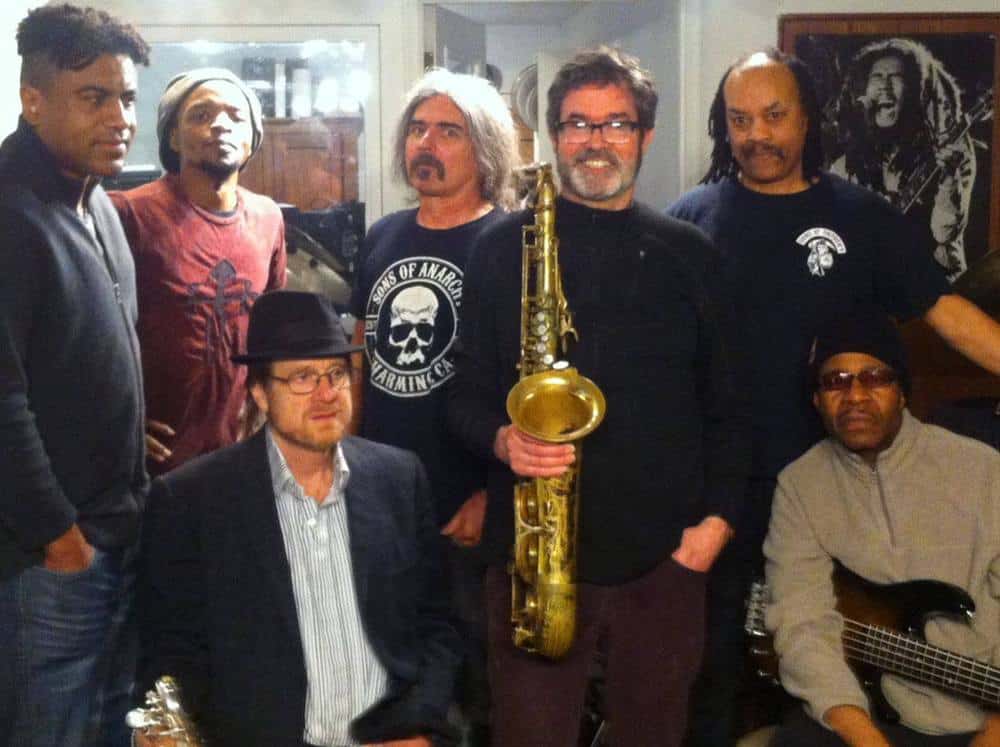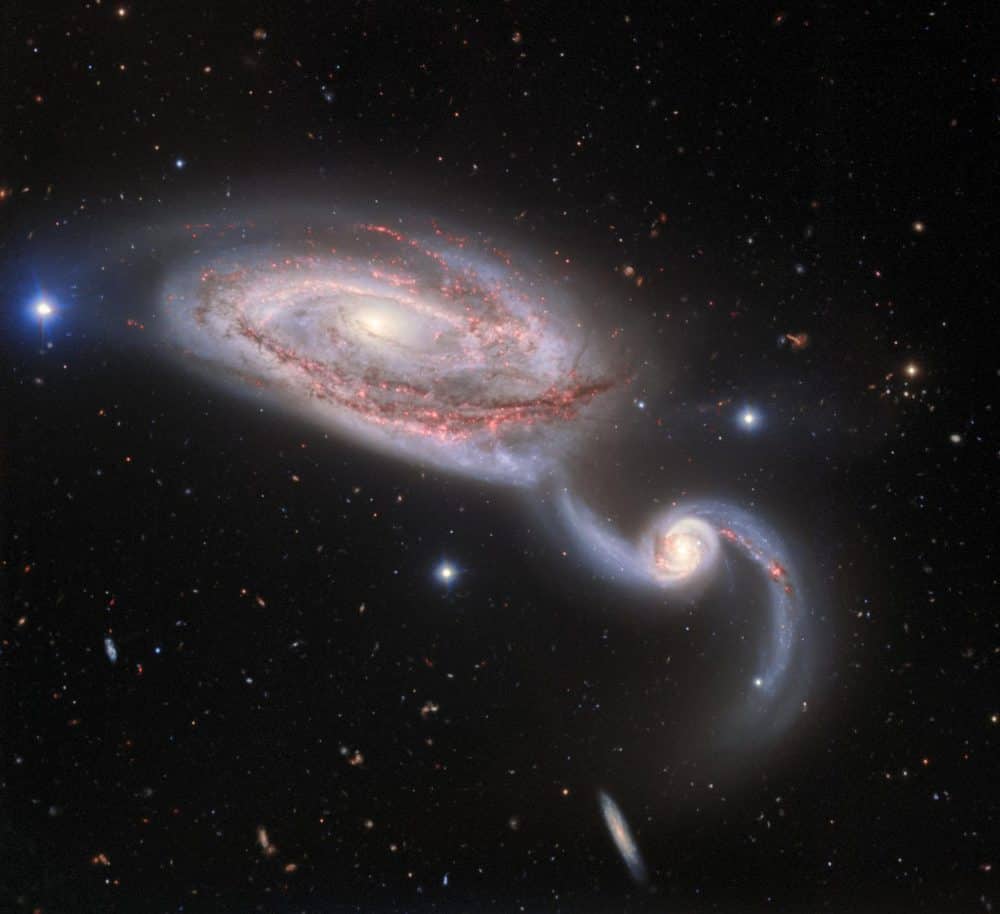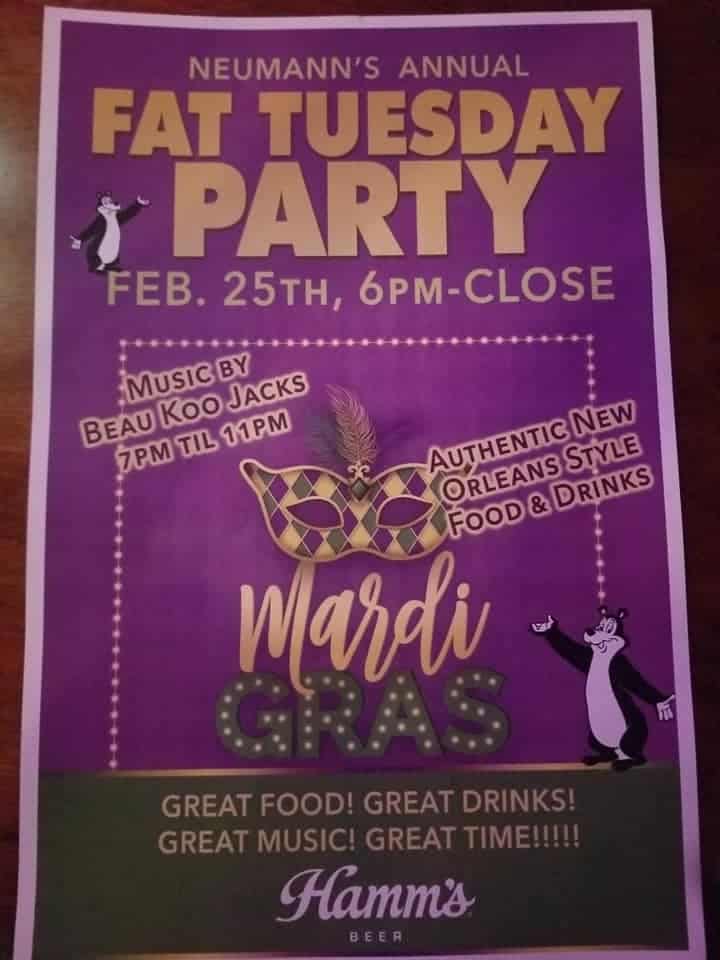Blog
Neumanns Bar
2531 7th Ave E, North St Paul, MN 55109 (651) 770-6020
Bring your Mardi Gras beads and your Gris Gris pouch.
With Jamie Carter, Todd Matheson, Larry McCabe, Paul Strickland, Jesse Mueller, Torrion Amie, Art Haynes and mick wazoo!

Image of the interacting galaxy pair NGC 5394/5 obtained with NSF’s National Optical-Infrared Astronomy Research Laboratory’s Gemini North 8-meter telescope on Hawai’i’s Maunakea using the Gemini Multi-Object Spectrograph in imaging mode. Credit: NSF’s National Optical-Infrared Astronomy Research Laboratory/Gemini Observatory/AURA.
NGC 5395 is an interacting spiral galaxy located at a distance of 160 million light years, but receding away from the earth at 3511 kilometers (2181.6 miles) per second, in the constellation Canes Venatici. It was discovered by William Herschel on May 16, 1787. NGC 5395 and NGC 5394 are included in the Atlas of Peculiar Galaxies as Arp 84 in the category “Spiral galaxies with large high surface brightness companions”.
NGC 5395 is the larger spiral galaxy interacting with smaller barred spiral galaxy, NGC 5394. NGC 5395 is nearly face-on, with a diameter of around 140,000 light-years across. NGC 5395 has a bright central region and is distorted due to the interaction with NGC 5394. The larger of the two rings around the galaxy forms a ring off the center of the galaxy. Dust lanes can be seen throughout the galaxy.
NGC 5394 is the smaller barred spiral galaxy interacting with larger spiral galaxy, NGC 5395. NGC 5394 has an oval disk, with a diameter of around 90 thousand light years across. It is also located at a distance of 160 million light-years across but receding away from the earth at a distance of 3448 kilometers (2142.4 miles) per second. Most of the gas is concentrated at the center of the galaxy, however, two out of the three spiral arms show no sign of ongoing star formation.

more...
George Harrison MBE (25 February 1943 – 29 November 2001) was an English musician, singer-songwriter, and music and film producer who achieved international fame as the lead guitarist of the Beatles. Sometimes called “the quiet Beatle”, Harrison embraced Indian culture and helped broaden the scope of popular music through his incorporation of Indian instrumentation and Hindu-aligned spirituality in the Beatles’ work. Although the majority of the band’s songs were written by John Lennon and Paul McCartney, most Beatles albums from 1965 onwards contained at least two Harrison compositions. His songs for the group included “Taxman“, “Within You Without You“, “While My Guitar Gently Weeps“, “Here Comes the Sun” and “Something“.
Harrison’s earliest musical influences included George Formby and Django Reinhardt; Carl Perkins, Chet Atkins and Chuck Berry were subsequent influences. By 1965, he had begun to lead the Beatles into folk rock through his interest in Bob Dylan and the Byrds, and towards Indian classical music through his use of the sitar on “Norwegian Wood (This Bird Has Flown)“. Having initiated the band’s embracing of Transcendental Meditation in 1967, he subsequently developed an association with the Hare Krishna movement. After the band’s break-up in 1970, Harrison released the triple album All Things Must Pass, a critically acclaimed work that produced his most successful hit single, “My Sweet Lord“, and introduced his signature sound as a solo artist, the slide guitar. He also organised the 1971 Concert for Bangladesh with Indian musician Ravi Shankar, a precursor to later benefit concerts such as Live Aid. In his role as a music and film producer, Harrison produced acts signed to the Beatles’ Apple record label before founding Dark Horse Records in 1974 and co-founding HandMade Films in 1978.
Harrison released several best-selling singles and albums as a solo performer. In 1988, he co-founded the platinum-selling supergroup the Traveling Wilburys. A prolific recording artist, he was featured as a guest guitarist on tracks by Badfinger, Ronnie Wood and Billy Preston, and collaborated on songs and music with Dylan, Eric Clapton, Ringo Starr and Tom Petty, among others. Rolling Stone magazine ranked him number 11 in their list of the “100 Greatest Guitarists of All Time”. He is a two-time Rock and Roll Hall of Fame inductee – as a member of the Beatles in 1988, and posthumously for his solo career in 2004.
Harrison’s first marriage, to model Pattie Boyd in 1966, ended in divorce in 1977. The following year he married Olivia Arias, with whom he had a son, Dhani. Harrison died from lung cancer in 2001 at the age of 58, two years after surviving a knife attack by an intruder at his Friar Park home. His remains were cremated and the ashes were scattered according to Hindu tradition in a private ceremony in the Ganges and Yamuna rivers in India. He left an estate of almost £100 million.
more...Hal Blaine (born Harold Simon Belsky; February 5, 1929 – March 11, 2019) was an American drummer and session musician, estimated to be among the most recorded studio drummers in the history of the music industry, claiming over 35,000 sessions and 6,000 singles. His drumming is featured on 150 US top 10 hits, 40 of which went to number one, as well as many film and television soundtracks.
Born in Holyoke, Massachusetts, Blaine moved with his family to California in 1943 and subsequently began playing jazz and big band music before taking up rock and roll session work. He became one of the regular players in Phil Spector‘s de facto house band, which Blaine nicknamed “the Wrecking Crew“. Some of the records Blaine played on include the Ronettes‘ single “Be My Baby” (1963), which contained a drum beat that became widely imitated, as well as works by popular artists such as Frank Sinatra, Elvis Presley, the Beach Boys, Simon & Garfunkel, Neil Diamond, and the Byrds.
Blaine’s workload declined from the 1980s onwards as recording and musical practices changed. In 2000, he was among the inaugural “sidemen” inductees to the Rock and Roll Hall of Fame, and in 2018 he received a Grammy Lifetime Achievement Award.
Blaine was born Harold Simon Belsky to Jewish Eastern European immigrants, Meyer and Rose Belsky (née Silverman), in Holyoke, Massachusetts, United States. When he was seven, he moved with his family to Hartford, Connecticut. He began playing drums at the age of eight, and again moved with his family to California in 1943.
more...René Thomas (25 February 1927 – 3 January 1975) was a jazz guitarist from Belgium.
In the early 1950s, he moved to Paris and became part of the modern jazz scene, playing in the style of Jimmy Raney. Back in Europe in 1962, he toured and recorded with Chet Baker, Bobby Jaspar, Kenny Clarke, Eddy Louiss, Stan Getz, Lucky Thompson, Sonny Criss, Jacques Pelzer, Lou Bennett, Charles “Lolo” Bellonzi, and Ingfried Hoffmann.
Thomas died of a heart attack in Santander, Spain at the age of 47 on 3 January 1975.
https://www.youtube.com/watch?v=GA4Iz3YA6fI
more...Ralph Edmund Stanley (February 25, 1927 – June 23, 2016) was an American bluegrass artist, known for his distinctive singing and banjo playing. Stanley began playing music in 1946, originally with his older brother Carter Stanley as part of The Stanley Brothers, and most often as the leader of his band, The Clinch Mountain Boys. He was also known as Dr. Ralph Stanley.
He was part of the first generation of bluegrass musicians and was inducted into both the International Bluegrass Music Hall of Honor and the Grand Ole Opry.
Stanley was born, grew up, and lived in rural Southwest Virginia—”in a little town called McClure at a place called Big Spraddle, just up the holler” from where he moved in 1936 and lived ever since in Dickenson County. The son of Lee and Lucy Stanley, Ralph did not grow up around a lot of music in his home. As he says, his “daddy didn’t play an instrument, but sometimes he would sing church music. And I’d hear him sing songs like ‘Man of Constant Sorrow,’ ‘Pretty Polly‘ and ‘Omie Wise.
more...Substitute teaching this week at Friends School, teaching Percussion & Guitar classes.
more...The spiral galaxy NGC 2008 sits center stage, its ghostly spiral arms spreading out towards us, in this image captured by the NASA/ESA Hubble Space Telescope.
This galaxy is located about 425 million light-years from Earth in the constellation of Pictor (The Painter’s Easel). Discovered in 1834 by astronomer John Herschel, NGC 2008 is categorized as a type Sc galaxy in the Hubble sequence, a system used to describe and classify the various morphologies of galaxies. The “S” indicates that NGC 2008 is a spiral, while the “c” means it has a relatively small central bulge and more open spiral arms. Spiral galaxies with larger central bulges tend to have more tightly wrapped arms, and are classified as Sa galaxies, while those in between are classified as type Sb.
Spiral galaxies are ubiquitous across the cosmos, comprising over 70% of all observed galaxies — including our own, the Milky Way. However, their ubiquity does not detract from their beauty. These grand, spiraling collections of billions of stars are among the most wondrous sights that have been captured by telescopes such as Hubble, and are firmly embedded in astronomical iconography.
A spiral galaxy is shaped like a disk. The disk tends to resemble a pinwheel with arms that spiral outward as it rotates. Spiral galaxies tend to contain more middle-aged stars along with clouds of gas and dust.

icholas Christian Hopkins (24 February 1944 – 6 September 1994) was an English pianist and organist. Hopkins recorded and performed on many notable British and American pop and rock music releases from the 1960s through the 1990s including many songs by The Rolling Stones, The Kinks and The Who.
Nicholas Christian Hopkins was born in Perivale, Middlesex, England, on 24 February 1944. He began playing the piano at the age of three. He attended Sudbury Primary School in Perrin Road and Wembley County Grammar School, which now forms part of Alperton Community School, and was initially tutored by a local piano teacher; in his teens he won a scholarship to the Royal Academy of Music in London. He suffered from Crohn’s disease for most of his life.
His poor health and repeated surgery later made it difficult for him to tour, and he worked mainly as a session musician for most of his career.Hopkins’ studies were interrupted in 1960 when he left school at 16 to become the pianist with Screaming Lord Sutch‘s Savages until, two years later, he and fellow Savages Bernie Watson, Rick Brown (aka Ricky Fenson) and Carlo Little joined the renowned blues harmonica player Cyril Davies, who had just left Blues Incorporated, and became the Cyril Davies (R&B) All-Stars. Hopkins played piano on their first single, Davies’ much-admired theme tune “Country Line Special”. However he was forced to leave the All Stars in May 1963 for a series of operations that almost cost him his life and he was bed-ridden for 19 months in his late teenage years. During Hopkins’ convalescence Davies died of leukemia and the All Stars disbanded. Hopkins’ frail health led him to concentrate on working as a session musician instead of joining bands, although he left his mark performing with a wide variety of famous bands. He quickly became one of London’s most in-demand session pianists and performed on many hit recordings from this period.
more...David “Fathead” Newman (February 24, 1933 – January 20, 2009) was an American jazz and rhythm-and-blues saxophonist who made numerous recordings as a session musician and leader, but is best known for his work as a sideman on seminal 1950s and early 1960s recordings by singer-pianist Ray Charles.
The AllMusic Guide to Jazz wrote that “there have not been many saxophonists and flutists more naturally soulful than David “Fathead” Newman,” and that “one of jazz’s and popular music’s great pleasures is to hear, during a vocalist’s break, the gorgeous, huge Newman tones filling the space…” Newman is sometimes cited as a leading exponent of the so-called “Texas Tenor” saxophone style, which refers to the many big-toned, bluesy jazz tenor players from that state.
Newman was born in Corsicana, Texas, on February 24, 1933, but grew up in Dallas, where he studied first the piano and then the saxophone. According to one account, he got his nickname “Fathead” in school when “an outraged music instructor used it as an epithet after catching Mr. Newman playing a Sousa march from memory rather than from reading the sheet music, which rested upside down on the stand.”
Inspired by the jump blues bandleader Louis Jordan, Newman took up the alto saxophone in the seventh grade, and was mentored by former Count Basie saxophonist Buster Smith. He went off to Jarvis Christian College on a music and theology scholarship but quit school after three years and began playing professionally, mostly jazz and blues, with a number of musicians, including Smith, pianist Lloyd Glenn, and guitarist bandleaders Lowell Fulson and T-Bone Walker.
more...Edwin Leon Chamblee (24 February 1920 – 1 May 1999), known as Eddie “Long Gone” Chamblee, was an American tenor and alto saxophonist, and occasional vocalist, who played jazz and R&B.
He was born in Atlanta, Georgia, and grew up in Chicago where he began learning the saxophone at the age of 12. After leaving Wendell Phillips High School, he studied law at Chicago State University, playing in clubs in the evenings and at weekends. He played in US Army bands between 1941 and 1946. After leaving the army, he joined Miracle Records. He played on Sonny Thompson‘s hit record “Long Gone” in 1948, and on its follow-up, “Late Freight“, credited to the Sonny Thompson Quintet featuring Eddie Chamblee. Both records reached no. 1 on the national Billboard R&B chart.Two follow-up records, “Blue Dreams” and “Back Street”, also made the R&B chart in 1949.
From 1947, he led his own band in Chicago clubs, as well as continuing to record with Thompson and on other sessions in Chicago, including The Four Blazes‘ no. 1 R&B hit “Mary Jo” in 1952. In 1954 he joined Lionel Hampton‘s band for two years, touring in Europe, before returning to lead his own group in Chicago. He accompanied both Amos Milburn and Lowell Fulson on some of their recordings, and then worked as accompanist to Dinah Washington on many of her successful recordings in the late 1950s and early 1960s. The two performed vocal duets in a style similar to that later adopted by Washington with Brook Benton, and were briefly married; he was her fifth husband. Chamblee also recorded for the Mercury and EmArcy labels, and with his own group in the early 1960s for the Roulette and Prestige labels.
In the 1970s he rejoined Hampton for tours of Europe, where he also played with Milt Buckner, and he recorded for the French Black & Blue label. He also performed with the Count Basie Orchestra in 1982, and from the 1980s until his death with the Harlem Blues and Jazz Band, as well as in clubs in New York City.
He died in New York in 1999 at the age of 79.
more...Celebration Carnival 2020 in Trinidad & Tobago
more...NGC 4689 is a spiral galaxy located about 54 million light-years away in the constellation of Coma Berenices. NGC 4689 is also classified as a LINER galaxy. NGC 4689 is inclined at an angle of about 36° which means that the galaxy is seen almost face-on to the Earth‘s line of sight. NGC 4689 was discovered by astronomer William Herschel on April 12, 1784.The galaxy is a member of the Virgo Cluster.

Wayne Escoffery (born 23 February 1975 in London, England) is an England-born American jazz saxophonist. He is based in New York City.
Since 2000, he has been working in New York City with Carl Allen, Eric Reed, and the Mingus Big Band. Other musicians performed with include Ralph Peterson, Ben Riley, Ron Carter, Rufus Reid, Bill Charlap, Bruce Barth, Jimmy Cobb, and Eddie Henderson. He has worked with vocalists including Mary Stallings, Cynthia Scott, Nancie Banks, LaVerne Butler, and Carolyn Leonhart. In addition to performing with his own Quartet featuring David Kikoski, Ugonna Okegwo and Ralph Peterson, Escoffery currently performs and tours with Ben Riley‘s Monk Legacy Septet, The Mingus Band, Ron Carter’s great Big Band, Monty Alexander, Amina Figarova and many others. He is currently a member of The Tom Harrell Quintet and has been since 2006. He has also co-produced four of Harrell’s latest recordings.
All About Jazz‘s J. Robert Bragonier said that Escoffery “is a talented youngster capable of long, flowing lines, noteworthy creativity, and a broad range of expressiveness.”
more...Norman Russell “Rusty” Young (born February 23, 1946, in Long Beach, California) is an American guitarist, vocalist and songwriter best known as one of the frontmen in the influential country rock and Americana band Poco.
A virtuoso on pedal steel guitar, he is celebrated for the ability to get a Hammond B3 organ sound out of the instrument by playing it through a Lesliespeaker cabinet and as an innovator of producing other rock sounds from the instrument.
Young was raised in Colorado. He began playing lap steel guitar at age 6, and taught guitar and steel guitar lessons during his high school years. During that time, he also played country music in late night bars. Rusty played in a well known Denver psychedelic rock band “Boenzee Cryque”.
In the late 1960s, a former guitar student became the road manager for Buffalo Springfield. Richie Furay and Jim Messina needed a steel guitarist for the Furay ballad “Kind Woman” on their final album Last Time Around and Young was hired.
Along with Furay and Messina, Young became a founding member of Poco in 1968 upon the former band’s demise. Drummer George Grantham and bass player Randy Meisner rounded out the original Poco lineup.
more...John Dawson Winter III (February 23, 1944 – July 16, 2014), known as Johnny Winter, was an American musician, singer, songwriter, multi-instrumentalist, and producer. Best known for his high-energy blues-rock albums and live performances in the late 1960s and 1970s, Winter also produced three Grammy Award-winning albums for blues singer and guitarist Muddy Waters. After his time with Waters, Winter recorded several Grammy-nominated blues albums. In 1988, he was inducted into the Blues Foundation Hall of Fame and in 2003, he was ranked 63rd in Rolling Stonemagazine’s list of the “100 Greatest Guitarists of All Time“.
Johnny Winter was born in Beaumont, Texas, on February 23, 1944. He and younger brother Edgar (born 1946) were nurtured at an early age by their parents in musical pursuits. Their father, Leland, Mississippi, native John Dawson Winter, Jr. (1909–2001), was also a musician who played saxophone and guitar and sang at churches, weddings, Kiwanis and Rotary Club gatherings. Johnny and his brother, both of whom were born with albinism, began performing at an early age. When he was ten years old, the brothers appeared on a local children’s show with Johnny playing ukulele.
His recording career began at the age of fifteen, when his band Johnny and the Jammers released “School Day Blues” on a Houston record label.During this same period, he was able to see performances by classic blues artists such as Muddy Waters, B.B. King, and Bobby Bland. In the early days, Winter would sometimes sit in with Roy Head and the Traits when they performed in the Beaumont area, and in 1967, Winter recorded a single with the Traits: “Tramp” backed with “Parchman Farm” (Universal Records 30496). In 1968, he released his first album The Progressive Blues Experiment, on Austin’s Sonobeat Records.
more...More Posts
- Boz Scaggs
- Derek Trucks
- Bill Watrous
- World Music Astrud Gilberto Memorial
- Daily Roots Skin Flesh & Bones
- Rhythm Roots Workshop Cerenity Humboldt Senior Care
- Cosmos M94
- Johnny Clegg
- Tina Brooks
- Tal Farlow
- World Drumming Babatunde Olatunji
- Daily Roots Al Brown
- Cosmos M20
- Paul Bollenback
- Jimmie Lunceford
- Monty Alexander
- Grant Green
- World Music Oumar Konate
- Daily Roots Tristan Palmer
- Diego LaBriola Memorial 2023
